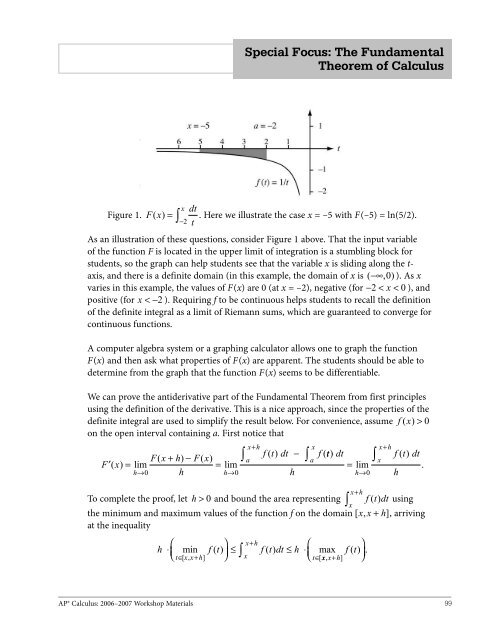AP Calculus
Create successful ePaper yourself
Turn your PDF publications into a flip-book with our unique Google optimized e-Paper software.
Special Focus: The Fundamental<br />
Theorem of <strong>Calculus</strong><br />
x<br />
∫ 2<br />
Figure 1. F( x) = −<br />
dt<br />
t<br />
. Here we illustrate the case x = –5 with F(–5) = ln(5/2).<br />
As an illustration of these questions, consider Figure 1 above. That the input variable<br />
of the function F is located in the upper limit of integration is a stumbling block for<br />
students, so the graph can help students see that the variable x is sliding along the t-<br />
axis, and there is a definite domain (in this example, the domain of x is ( −∞, 0 ) ). As x<br />
varies in this example, the values of F(x) are 0 (at x = –2), negative (for − 2 < x < 0 ), and<br />
positive (for x < −2 ). Requiring f to be continuous helps students to recall the definition<br />
of the definite integral as a limit of Riemann sums, which are guaranteed to converge for<br />
continuous functions.<br />
A computer algebra system or a graphing calculator allows one to graph the function<br />
F(x) and then ask what properties of F(x) are apparent. The students should be able to<br />
determine from the graph that the function F(x) seems to be differentiable.<br />
We can prove the antiderivative part of the Fundamental Theorem from first principles<br />
using the definition of the derivative. This is a nice approach, since the properties of the<br />
definite integral are used to simplify the result below. For convenience, assume f ( x) > 0<br />
on the open interval containing a. First notice that<br />
F x + h − F x<br />
F′ ( x) = lim ( ) ( ) = lim<br />
h→0 h<br />
h→0<br />
∫<br />
x+<br />
h<br />
a<br />
∫<br />
x<br />
f ( t) dt − f ( t)<br />
dt<br />
a<br />
= lim<br />
h<br />
h→0<br />
∫<br />
x+<br />
h<br />
x<br />
f ( t)<br />
dt<br />
.<br />
h<br />
To complete the proof, let h > 0 and bound the area representing ∫ f ( t)<br />
dt using<br />
x<br />
the minimum and maximum values of the function f on the domain [ x, x + h]<br />
, arriving<br />
at the inequality<br />
h ⋅ ⎛ min f t f t dt h<br />
⎝ ⎜ ( ) ⎞<br />
[ ] ⎠<br />
⎟ ≤ x h<br />
∫ ( ) ≤ ⋅ max<br />
x<br />
⎝<br />
⎜<br />
+ ⎛<br />
t∈ x, x+ h t∈[<br />
x, x+<br />
h]<br />
x+<br />
h<br />
⎞<br />
f ( t) .<br />
⎠<br />
⎟<br />
<strong>AP</strong>® <strong>Calculus</strong>: 2006–2007 Workshop Materials 99


